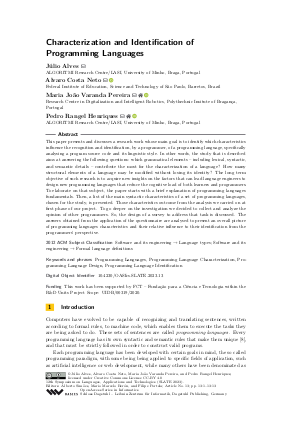Characterization and Identification of Programming Languages
Authors
Júlio Alves,
Alvaro Costa Neto  ,
Maria João Varanda Pereira
,
Maria João Varanda Pereira  ,
Pedro Rangel Henriques
,
Pedro Rangel Henriques 
-
Part of:
Volume:
12th Symposium on Languages, Applications and Technologies (SLATE 2023)
Part of: Series: Open Access Series in Informatics (OASIcs)
Part of: Conference: Symposium on Languages, Applications and Technologies (SLATE) - License:
 Creative Commons Attribution 4.0 International license
Creative Commons Attribution 4.0 International license
- Publication Date: 2023-08-15
File

PDF
OASIcs.SLATE.2023.13.pdf
- Filesize: 0.54 MB
- 13 pages
Document Identifiers
Subject Classification
ACM Subject Classification
- Software and its engineering → Language types
- Software and its engineering → Formal language definitions
Keywords
- Programming Languages
- Programming Language Characterization
- Programming Language Design
- Programming Language Identification
Metrics
- Access Statistics
-
Total Accesses (updated on a weekly basis)
0PDF Downloads0Metadata Views
Abstract
This paper presents and discusses a research work whose main goal is to identify which characteristics influence the recognition and identification, by a programmer, of a programming language, specifically analysing a program source code and its linguistic style. In other words, the study that is described aims at answering the following questions: which grammatical elements - including lexical, syntactic, and semantic details - contribute the most for the characterization of a language? How many structural elements of a language may be modified without losing its identity? The long term objective of such research is to acquire new insights on the factors that can lead language engineers to design new programming languages that reduce the cognitive load of both learners and programmers. To elaborate on that subject, the paper starts with a brief explanation of programming languages fundamentals. Then, a list of the main syntactic characteristics of a set of programming languages, chosen for the study, is presented. Those characteristics outcome from the analysis we carried on at first phase of our project. To go deeper on the investigation we decided to collect and analyze the opinion of other programmers. So, the design of a survey to address that task is discussed. The answers obtained from the application of the questionnaire are analysed to present an overall picture of programming languages characteristics and their relative influence to their identification from the programmers’ perspective.
Cite As Get BibTex
Júlio Alves, Alvaro Costa Neto, Maria João Varanda Pereira, and Pedro Rangel Henriques. Characterization and Identification of Programming Languages. In 12th Symposium on Languages, Applications and Technologies (SLATE 2023). Open Access Series in Informatics (OASIcs), Volume 113, pp. 13:1-13:13, Schloss Dagstuhl – Leibniz-Zentrum für Informatik (2023)
https://doi.org/10.4230/OASIcs.SLATE.2023.13
BibTex
@InProceedings{alves_et_al:OASIcs.SLATE.2023.13,
author = {Alves, J\'{u}lio and Costa Neto, Alvaro and Pereira, Maria Jo\~{a}o Varanda and Henriques, Pedro Rangel},
title = {{Characterization and Identification of Programming Languages}},
booktitle = {12th Symposium on Languages, Applications and Technologies (SLATE 2023)},
pages = {13:1--13:13},
series = {Open Access Series in Informatics (OASIcs)},
ISBN = {978-3-95977-291-4},
ISSN = {2190-6807},
year = {2023},
volume = {113},
editor = {Sim\~{o}es, Alberto and Ber\'{o}n, Mario Marcelo and Portela, Filipe},
publisher = {Schloss Dagstuhl -- Leibniz-Zentrum f{\"u}r Informatik},
address = {Dagstuhl, Germany},
URL = {https://drops.dagstuhl.de/entities/document/10.4230/OASIcs.SLATE.2023.13},
URN = {urn:nbn:de:0030-drops-185273},
doi = {10.4230/OASIcs.SLATE.2023.13},
annote = {Keywords: Programming Languages, Programming Language Characterization, Programming Language Design, Programming Language Identification}
}
Author Details
- Federal Institute of Education, Science and Technology of São Paulo, Barretos, Brazil
- Research Centre in Digitalization and Intelligent Robotics, Polythechnic Insitute of Bragança, Portugal
Funding
This work has been supported by FCT – Fundação para a Ciência e Tecnologia within the R&D Units Project Scope: UIDB/00319/2020.
References
-
Sam A Abolrous. Learn C-Sharp - Includes the C-Sharp 3.0 Features. Wordware Pub, 2007.

-
Alfred V. Aho, Monica S. Lam, Ravi Sethi, and Jeffrey D. Ullman. Compilers: principles, techniques & tools. Addison Wesley, 2007.

-
Francesca Del Bonifro, Maurizio Gabbrielli, Antonio Lategano, and Stefano Zacchiroli. Image-based many-language programming language identification. PeerJ Computer Science, 7, 2021.

- Alvaro Costa Neto, Cristiana Araújo, Maria João Varanda Pereira, and Pedro Rangel Henriques. Value-Focused Investigation into Programming Languages Affinity. In Alberto Simões and João Carlos Silva, editors, Third International Computer Programming Education Conference (ICPEC 2022), volume 102 of Open Access Series in Informatics (OASIcs), pages 1:1-1:12, Dagstuhl, Germany, 2022. Schloss Dagstuhl - Leibniz-Zentrum für Informatik. URL: https://doi.org/10.4230/OASIcs.ICPEC.2022.1.
-
Robert W. Floyd. The syntax of programming languages, 1964.

-
James Gosling, William N. Joy, and Guy L. Steele. The java language specification, 1996.

- Ralph L. Keeney. Value-focused thinking: Identifying decision opportunities and creating alternatives. European Journal of Operational Research, 92(3):537-549, 1996. URL: https://doi.org/10.1016/0377-2217(96)00004-5.
-
Jyotiska Nath Khasnabish, Mitali Sodhi, Jayati Deshmukh, and Gopalakrishnan Srinivasaraghavan. Detecting programming language from source code using bayesian learning techniques. In MLDM, 2014.

-
David Klein, Kyle Murray, and Simon Weber. Algorithmic programming language identification. ArXiv, abs/1106.4064, 2011.

-
Dave Kuhlman. A Python Book: Beginning Python, Advanced Python, and Python Exercises. Platypus Global Media, 2015.

-
Miran Lipovaca. Learn You a Haskell for Great Good! A Beginner’s Guide. No Starch Press, 2011.

-
Tom Mitchell. Machine learning, 1997.

-
Alvaro Costa Neto, Cristiana Araújo, Maria João Varanda Pereira, and Pedro Rangel Henriques. Programmers' affinity to languages. In ICPEC, 2021.

-
Easy Programming. C Programming Language The Ultimate Beginner’s Guide. CreateSpace Independent Publishing Platform, 2016.

-
Bjarne Stroustrup. A History of C++: 1979-1991, pages 699-769. Association for Computing Machinery, New York, NY, USA, 1996.

-
Peter Norvig Stuart Russell. Artificial Intelligence: A Modern Approach. Prentice Hall Series in Artificial Intelligence. Prentice Hall, 3rd edition, 2010.

-
Shaul Zevin and Catherine Holzem. Machine learning based source code classification using syntax oriented features. ArXiv, abs/1703.07638, 2017.

